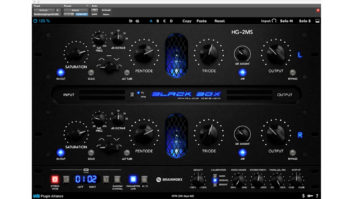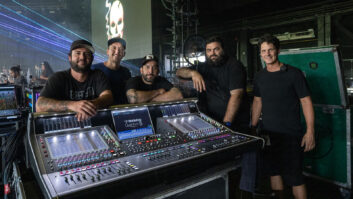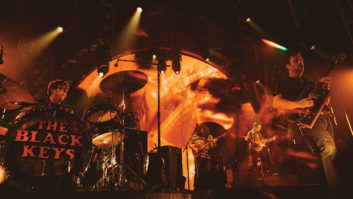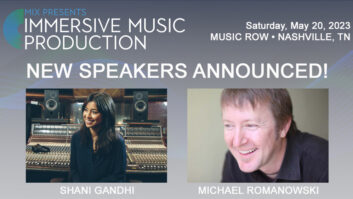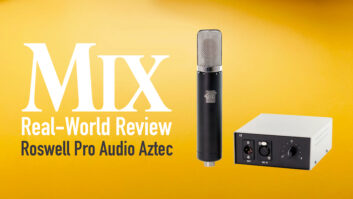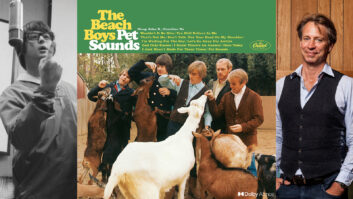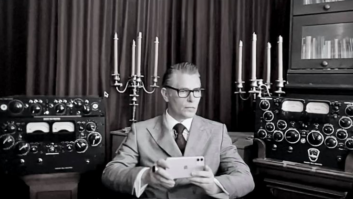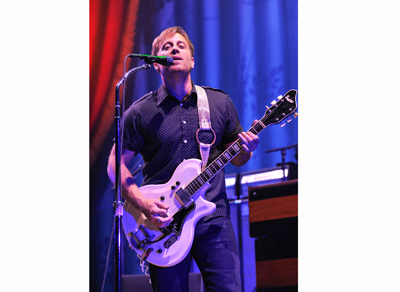
When Jason Tarulli started mixing front-of-house for the Black Keys, band mates Dan Auerbach and Patrick Carney were still playing clubs in and near their hometown of Akron, Ohio. “I’ve been with them about seven years on the road, and before that, I worked in clubs and small venues across northeast Ohio,” Tarulli says. “I believe that the first show I worked with them might have been their third or fourth show that they ever played; it was in a small club in downtown Akron, called The Lime Spider, and it’s still crazy to think back on it and to look where we are now.”
At press time, the Keys were about to take a short break between legs of a U.S. arena tour. They’ve been mainly on the road since their latest album, Turn Blue, released this past May, playing wall-to-wall rock ’n’ roll from throughout their catalog, but highlighting songs from Turn Blue, as well as from the 2011 smash El Camino. Auerbach and Carney are joined onstage by bassist Richard Swift (The Shins) and keyboardist John Wood. Mix caught the Black Keys’ show at Oracle Arena in Oakland, Calif.
As frontmen go, Auerbach is kind of a quiet guy; he’s not big on stage patter beyond occasionally inviting the audience to “help us out with this one if you know it” before playing a hit like “Gold on the Ceiling.” Likewise, the Keys’ visuals are most striking for their spare-ness. A few songs in, a fabric backdrop with a picture of red velvet curtains falls from behind the band, baring rigging, white lights, and a few small screens. Artifice is gone; music does the talking.

The Black Keys’ Patrick Carney at Oracle Arena in Oakland, Calif. Photo: Steve Jennings
Eighth Day Sound has been supplying full audio production, including the d&b J-Series P.A., Tarulli’s Midas PRO6 console, and outboard gear such as an Empirical Labs Distressor and Eventide H3000 Harmonizer for vocals, TC Electronic D-Two delay for slapback on vocals, SPL Transient Designer for drums, a pair of dbx 160 compressors for snare drum and bass guitar, an Alan Smart bus compressor and a Thermionic Culture Vulture for drums, an Overstayer Saturator to add some dirt to the main vocals, as well as a few boutique items:
“I have a couple of custom-made Pultec EQP-1 program EQs that I use on the left and right out of the desk,” Tarulli says. “These were made by James Wielding out of a small Ohio company called Fantastic Apparatus. He was able to source new old stock Triad and UTC transformers, and the appropriate inductors to build these boxes that are essentially old-school passive EQs with a bit of tube make-up gain. They add an interesting bit of color that tends to smooth out the digital-ness of the desk.”
The band has an endorsement deal with Sennheiser, which allowed the crew to check out and choose several microphones. All vocals are to Sennheiser 945s. On Carney’s drum kit, there are a 901 and 902 on kick, and 904s on toms. Snare is miked with Sennheiser 441 on top and a Shure Beta 57 underneath. The hi-hat mic is a Neumann KM187. There is also a pair of KM184s for overheads, and a Sennheiser 441 on the cowbell.
“Both of the guys came to me a long time ago and expressed how important it is to keep drums up-front,” Tarulli says. “A lot of my work goes into keeping the dynamics under control and making sure the drums are up-front—as powerful as we can make them without overpowering the rest of the band.

Front-of-house engineer Jason Tarulli (at left) at the Midas PRO6 console, with Systems Tech Richie Gibson. Photo: Steve Jennings
“I parallel-bus the toms and snare into one side of the Alan Smart compressor, and those go into one side of the Thermionic Culture Vulture to dirty the drums up a bit,” Tarulli continues. “This seems to thicken the drums up quite a bit, and with the dbx on the snare at, maybe four-to-one compression, if I turn all of this up, the snare sounds like a shotgun.”
Guitars are mainly taken from Palmer DIs. “The signal is taken from the output of the amplifiers. Dan runs four guitar amps, on full all the time,” Tarulli says. “There’s a Marshall JTM45 with a tape-delay slapback, a vintage Fender Quad Reverb with the reverb cranked, and a pair of vintage Danelectros. All four are patched into a large rack of effects—vintage pedals and switchers. The amps are facing into one another, and the back amps have a lot of awful phasing going on. There are mics on the amps, but there tends to be a lot of weird cancellation that’s not pleasing, so I lean about 90 percent on those Palmers.”
Monitor mixer Rob Elliott (Gomez, The Cure) is likewise pretty hands-off with Auerbach’s guitars. Also mixing from a Midas PRO6, to all d&b M2 wedges onstage, he adds zero guitar sound to the frontman’s monitors. “In Dan’s front wedges, he just likes his vocal,” Elliott says. “Then he has a sidefill with kick, snare, bass and keyboards mainly. But he can hear his guitar behind him [through the amps] because it’s pretty loud! Dan’s pretty easygoing; as long as he can hear his voice and the keyboards in the monitors, he’s set.
“Patrick likes a more full mix in his monitors. Heavy drums: the kick, snare, toms are quite loud in there, obviously, and Dan’s guitar is up there, too, along with the bass. And the monitor [mixes] are all dry—straight in, straight out,” he says. “They’re a loud rock ’n’ roll band. What you hear is what you get.”

Monitor engineer Robert Elliot also mixes on a Midas PRO6. Photo: Steve Jennings

